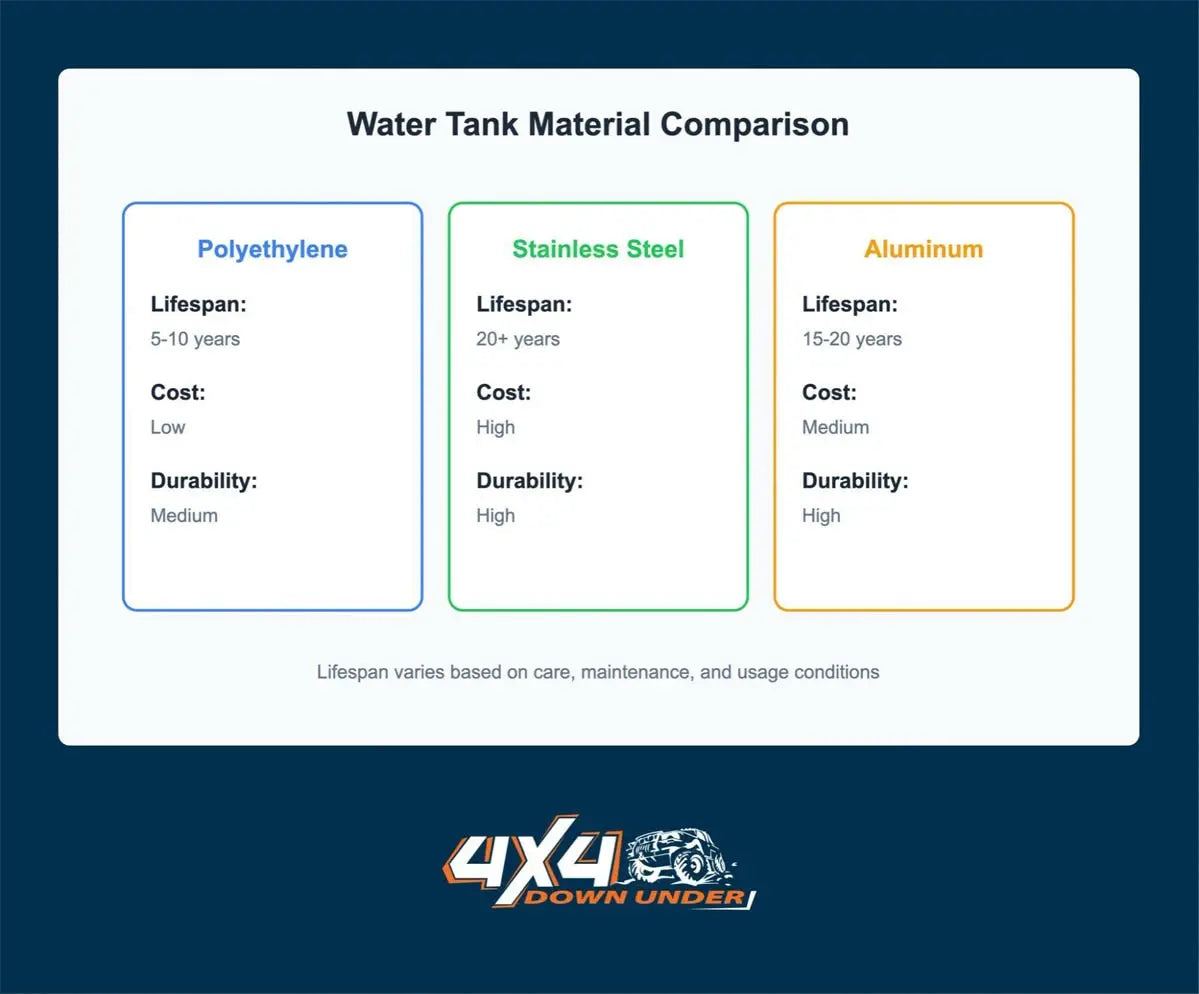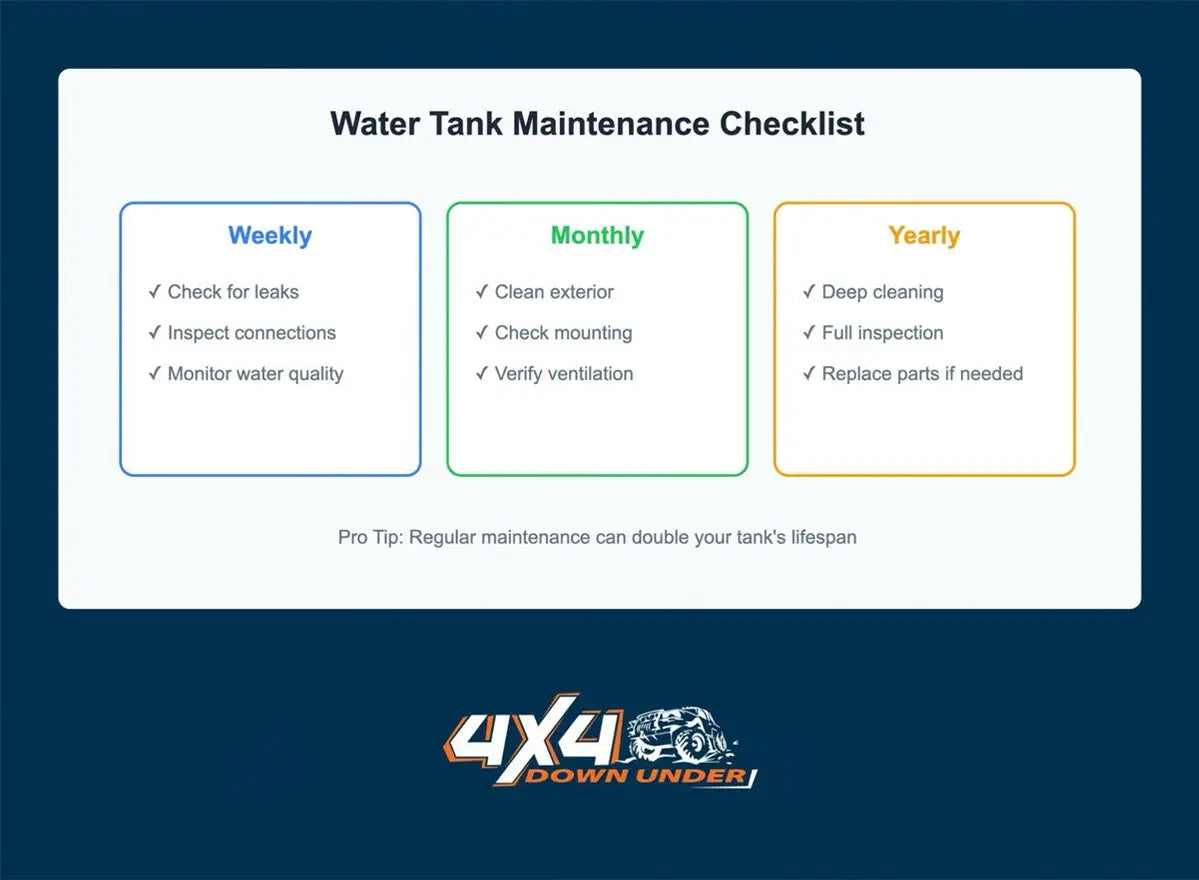Reach us here or email info@4x4downunder.com.au

How Long Do Water Tanks Last? A Guide for Campers and 4x4 Owners
From Materials to Maintenance: How to Extend Your Water Tank’s Life
If you're a camper or 4x4 owner, you know how important it is to have a reliable water supply when you're out on the trails. But have you ever wondered how long your water tank will actually last? In this guide, we'll dive into what affects the lifespan of water tanks and provide tips on how to make them last as long as possible, so you can stay hydrated and ready for any adventure.
Water tanks for camping and 4x4 excursions typically last:
- Polyethylene: 5-10 years
- Stainless steel: 20+ years
- Aluminium: 15-20 years
But lifespan depends on care and use. Here's what impacts tank life:
- Material quality
- Sun exposure
- Temperature changes
- Usage frequency
- Maintenance
To make your tank last:
- Clean regularly
- Check for damage
- Store properly
- Use correct mounting (for 4x4s)
When to replace:
- Cracks or leaks
- Odd taste/smell
- Reduced flow
- Visible wear
Quick Comparison:
| Material | Lifespan |
Cost |
Durability |
|---|---|---|---|
| Polyethylene | 5-10 years | Low | Medium |
| Stainless Steel | 20+ years | High | High |
| Aluminium | 15-20 years | Medium | High |
Choose based on your needs, budget, and vehicle. Regular maintenance is key for any tank type.

Why Water Tanks Matter
For campers and 4x4 fans, water is everything. Here's the deal:
- You can't live without it. Your body taps out after about three days without water.
- It's a time-saver. A good tank means less running around looking for water sources.
- It's not just for drinking. You need water for cooking, cleaning, and even keeping your ride in shape.
Picking Your Perfect Tank
Choosing a water tank is like picking a travel buddy. You want one that fits your needs:
|
What to Consider |
Why It Matters |
|
How much it holds |
Aim for around 4 litres per person per day |
|
What it's made of |
Affects how long it lasts and keeps water safe |
|
How easy it is to move |
Think about your vehicle and where you'll store it |
|
How tough it is |
Look for UV-resistant and BPA-free materials |
|
The price tag |
Balance what you pay with how long it'll last |
Take the Boab 40L Footwell Water Tank bundle, for example. It's got a water pump for easy water flow when you're camping, along with the hose kits for easy setup. The tank is made from food-grade, BPA-free, UV-resistant polyethylene - fancy talk for "your water stays clean and safe."
Keep Your Tank in Top Shape
Want your tank to stick around? Here's how:
- Clean it often
- Check for damage before and after trips
- Store it right when you're not using it
- Use the right mounting gear for 4x4 vehicles
Do these things, and your water tank will be your reliable adventure partner for a long time.
How Long Different Tank Materials Last
The material of your water tank for camping and 4x4 adventures affects its lifespan. Let's look at the main types and how long they last.
Types of Tank Materials and Their Lifespan
There are three main materials for water tanks:
- Polyethylene (PE): Lasts 5-10 years
- Stainless steel: Lasts 20+ years
- Aluminium: Lasts 15-20 years
Here's a quick comparison:
|
Material |
Average Lifespan |
Cost |
Notes |
|
Polyethylene |
5-10 years |
$ |
Most common, affordable |
|
Stainless Steel |
20+ years |
$$$ |
Priciest but very durable |
|
Aluminium |
15-20 years |
$$ |
Lightweight, good for 4x4s |
Remember, these are estimates. Your tank's life depends on how you use and care for it.
What Affects Tank Life
Several things can make your tank last longer or shorter:
- Sun exposure
- Temperature changes
- How often you use it
- Water quality
For example, leaving a plastic tank in the sun will cause it to break down faster. As one customer said, "Plastics will break down over time, a few years, and be toxic."
Choosing the Right Tank
When picking a tank, think about:
- How often you'll use it
- Your budget
- Your vehicle's weight limit
Stainless steel tanks last the longest but cost the most. One prepper said, "Stainless steel is pretty much going to be the best container you can get to store water in." But they can cost 10-20 times more than plastic ones.
Polyethylene tanks are cheap and light, great for short trips or occasional use.
Aluminium tanks are a middle ground - almost as tough as stainless steel, but lighter and cheaper.
No matter which you choose, take care of your tank. Clean it often, check for damage, and store it properly. Do this, and your tank will be ready for many future trips.
When to Replace Your Tank
Let's talk about when it's time to swap out your water tank. This is crucial info for campers and 4x4 fans.
Physical Signs
Your tank might be telling you it's had enough. Here's what to look for:
- Cracks on the sides or top
- Weird colour changes
- Any warping or funky shapes
Water Issues
Sometimes, the water itself gives you clues:
- Water's not flowing like it used to?
- Taste off?
- Seeing bits of stuff floating around?
These could all mean your tank's on its last legs.
Material Matters
Different tanks wear out in their own special ways:
|
Material |
How It Wears |
|
Polyethylene |
Gets brittle, shows UV damage |
|
Stainless Steel |
Corrosion around welds |
|
Aluminium |
Pitting, chalky stuff appears |
Quick Problem Checklist
Here's a handy guide to tank troubles:
|
Warning Sign |
Material |
How Bad Is It? |
|
Cracks |
Any |
Pretty bad |
|
Leaks |
Any |
Really bad |
|
Colour changes |
Plastic |
Medium bad |
|
Rust |
Metal |
Medium bad |
|
Algae |
Any |
Not great |
Checking your tank regularly is WAY cheaper than dealing with a sudden failure mess.
Don't wait for disaster. Regular check-ups can save you from a camping catastrophe.
For the 4x4 crowd: How's your tank mounted? Bad installation without flexible bits can mess up your pipes.
Not sure about your tank's health? Chat with the pros at 4x4 Down Under. They'll tell you if you need a new one or if some TLC might do the trick.
Making Your Tank Last Longer
Want your water tank to stick around? Here's the lowdown on keeping it in shape:
Setting Up Your Tank Right
Get this wrong, and you're in for a world of hurt. For 4x4 owners: mount that tank securely. Use flexible connections. Why? They'll soak up those nasty vibrations that can wreck your tank.

Basic Tank Care
It's not rocket science, but it's crucial. Here's your to-do list:
Check for leaks every time you hit the road. Once a month, give your tank a once-over for cracks or weird colours. And every six months? Time for a deep clean.
How to Clean Your Tank
Roll up your sleeves. Here's how it's done:
- Empty that tank. Every last drop.
- Mix up some bleach and water. (Stick around for the recipe.)
- Fill 'er up with your bleach cocktail. Let it sit for a day.
- Flush it out until the water runs clear.
- Fill it back up with fresh water.
|
Tank Size (Liters) |
Bleach (ml) |
|
50 |
6.25 |
|
100 |
12.50 |
|
200 |
25.00 |
|
300 |
37.50 |
|
400 |
50.00 |
|
500 |
62.50 |
Here's a money-saving tip: Regular old bleach will set you back about $2. Those fancy tank cleaners? Try $25 a pop!
Off-Season Tank Storage
When your tank's taking a break:
Drain it bone-dry. Why? Water expands when it freezes. That's bad news for your tank.
Clean it. Dry it. Mold is NOT your friend.
Keep it cool and dark. UV rays are tank killers.
When to Do What
|
Task |
How Often? |
Which Tanks? |
|
Look it over |
Before each trip |
All |
|
Sanitize |
Every 6 months |
All |
|
Deep clean |
Once a year |
All |
|
Check the mount |
Every 3 months |
4x4 |
|
Call in the pros |
Twice a year |
Big/Filtered |
"Want good-tasting, safe water? Sanitize that tank." - J.D. Power, Author
4x4 Tank Tips
Water tanks for your 4x4 aren't just about size. Here's how to keep your tank in top shape for off-road adventures.
How to Mount Tanks
Mounting your tank right is key. Here's the deal:
- Use straps, not bolts. Don't attach the tank directly to your vehicle.
- Put rubber or neoprene between the straps and tank. It cuts down on stress.
- Give your tank some wiggle room. It'll soak up vibrations and avoid damage.
"A well-mounted tank lasts years. A poorly mounted one? It might not survive your first trip", says Keith, a seasoned 4x4 enthusiast.
Protecting Your Tank
Shield your tank from the elements:
- Keep it out of direct sunlight. UV damage and overheating are no joke.
- Think about adding a cover or shield. It'll fend off rocks and debris.
- Find a spot that's sheltered from the undercarriage. Road hazards are real.
Dealing with Hot and Cold
Temperature swings can mess up your tank. Here's how to handle them:
- Leave room for expansion and contraction. It'll prevent stress cracks.
- Insulate if you can, especially in extreme weather.
- Pick a tank material that can handle temperature changes. UV-stabilised polyethylene is a good bet.
Reducing Shake and Rattle
Less movement means a safer tank and contents:
- Use flexible connections for pipes. They'll absorb vibrations.
- Check and tighten straps often, especially after rough rides.
- Consider adding anti-vibration pads to your setup.
Mount Types and Results
|
Mount Type |
Vibration Reduction |
Ease of Installation |
Durability |
|
Rigid Bolt |
Low |
High |
Medium |
|
Strap System |
High |
Medium |
High |
|
Cradle Mount |
Very High |
Low |
Very High |
|
Shock-Absorbing |
Excellent |
Medium |
High |
The right mount makes a big difference. Take the Stirling GT. It used a custom cradle mount for its 100+ liter tank on a trip around Australia. Result? Stable and long-lasting.
Picking the Right Tank
Choosing a water tank for your 4x4 or camping setup can make or break your adventure. Here's what you need to know:
How Much Water You Need
Start by figuring out your daily water needs. Aim for at least 20 liters per person per day. This covers drinking, cooking, and basic hygiene.
Think about:
- How long you'll be out there
- Who's coming along
- Where you're going (hot weather = more water)
- What you'll be doing (hiking, fishing, etc.)
"On our fishing trip trailer we fitted two tanks with taps so you only use one at a time. If the first tank is empty and you're at least halfway through the trip then you're winning." - Leethal, Experienced 4x4 camper
Choosing Tank Material
Your tank's material matters. It affects durability, weight, and water quality. Here's a quick look:
|
Material |
Pros |
Cons |
|
Polyethylene |
Light, cheap |
Can affect taste, less tough |
|
Stainless Steel |
Super tough, keeps water fresh |
Heavy, pricey |
|
Fiberglass |
Light, won't rust |
Can break if not reinforced |
For the long haul, go for fiberglass or stainless steel. As one expert puts it: "The best tank material to store portable drinking water has to be fiberglass because there's a big difference in quality."
Getting the Size Right
Balance your water needs with what your vehicle can handle. Think about:
- Space in your 4x4
- How it'll affect weight distribution
- Impact on fuel efficiency
For weekend trips, a 60-100 liter tank usually does the trick. Longer trips or bigger groups? You might need 150+ liters.
Setup Needs
Different tanks need different setups:
- Fixed tanks: Permanent installation, great for regular use
- Portable tanks: Flexible, perfect for occasional trips
- Slimline tanks: Fit tight spaces in smaller 4x4s
Here's a quick guide:
|
Usage |
Tank Type |
Size Range |
|
Weekend Trips |
Portable Polyethylene |
40-80L |
|
Extended Journeys |
Fixed Fiberglass |
100-200L |
|
Extreme Off-roading |
Reinforced Stainless Steel |
60-150L |
Pick the right tank, and you'll be set for your next adventure. Happy camping!
Wrap-Up
Let's recap the key points about choosing and maintaining water tanks for camping and 4x4 adventures.
Material Matters
Different tank materials have their pros and cons:
|
Material |
Lifespan |
Pros |
Cons |
|
Polyethylene |
5-10 years |
Light, cheap |
Taste issues, less tough |
|
Stainless Steel |
20+ years |
Super tough, great water |
Heavy, pricey |
|
Fiberglass |
15-20 years |
Light, no rust |
Can break if not reinforced |
Most campers and 4x4 fans find poly tanks hit the sweet spot for toughness, weight, and price. As one expert puts it:
"Personally though, I would go with poly tanks every time."
Keep It Clean
Regular upkeep can make your tank last way longer:
- Check for cracks or rust weekly
- Deep clean every 3-5 years (yearly in sandy areas)
- Use BioMagic WaterPure to keep it clean without weird tastes
Flexi-Liner nails it: "Proper prior maintenance makes a big difference down the road."
Set It Up Right
Good installation is crucial, especially for 4x4s:
- Use straps, not bolts (lets the tank expand)
- Add rubber between straps and tank (cuts vibration)
- Use flexible pipes (absorbs shocks)
Size Matters
Balance your water needs with what your vehicle can handle:
- Aim for 20+ liters per person per day
- Think about trip length and what you'll be doing
- Don't forget your vehicle's weight limits and space
FAQs
What is the lifespan of a rainwater tank?
A rainwater tank's lifespan isn't set in stone. It's like your camping gear - with proper care, it'll last a long time.
Here's what you need to know:
Most well-maintained tanks last 20-30 years. High-density crosslinked polyethylene (XLPE) tanks can go for 15-20 years, sometimes even 30-40% longer than linear polyethylene tanks.
But here's the thing: some tanks might only last two years, while others keep going for over three decades. It varies a lot.
Tucker Ballister, a content strategist, says: "The lifespan of your water tank depends on a lot of factors."
To make your tank last longer:
1. Do regular maintenance
Just like you'd maintain your 4x4, keep your tank in good shape.
2. Position it smartly
Think about shade and stability when placing your tank.
3. Choose quality materials
You get what you pay for with tanks.
Many campers and 4x4 enthusiasts have seen their tanks last for decades with good care. It's simple: take care of your gear, and it'll take care of you.
Want to get the most out of your tank? Keep an eye on it, clean it often, and don't hesitate to ask the manufacturer for advice. They know their product best!
Explore Water Tanks
Boab Poly Tapered Water Tank | 50 Litre
BoabBoab 50 Litre Poly Water Tank with Taper If you're planning on traveling to remote regions of Australia, it's essential to have a backup water su...
View Full DetailsBoab Poly 40L Footwell Water Tank
BoabPoly Footwell 40 Litre Water Tank - by BOAB Having a backup water supply is crucial when traveling in remote regions, where access to fresh water ...
View Full DetailsBoab Poly Water Tank Ute Mount | 55 Litre
BoabBoab 55 Litre Poly Water Tank - Ute Mount If you're planning on traveling to remote regions of Australia, or are just in need of convenient water ...
View Full DetailsBoab Water Tank Vertical & Flat | 45 Litre
BoabBoab Poly Water Tank 45 Litre Vertical & Flat This 45 Litre Boab Poly Water Tank can be fitted in Vertical or a Flat Position. Includes 1/2''...
View Full DetailsBoab Poly Double Jerry Can Water Tank | 40 Litre
Boab40 Litre Poly Double Jerry Can Water Tank by BOAB The Boab double jerry can 40 Litre water tank is a versatile and convenient solution for transpo...
View Full Details






